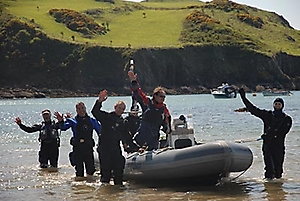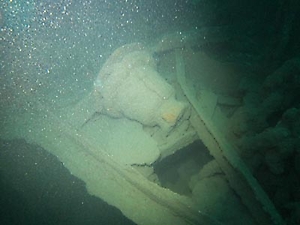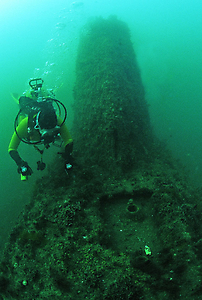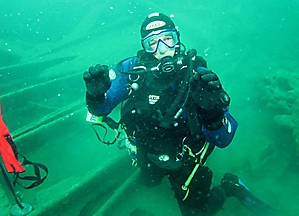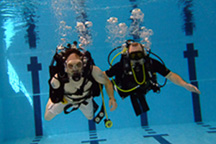Club Diving
Members of Southsea Sub-Aqua Club frequently dive along the South coast of England and have dived much of the rest of the UK and around the globe. The pages linked below provide some useful local information, as well as samples of what our members have done or are doing.
Some Mulberry 70 dives
- Details
- Category: Mulberry 70
Day 1 - Sat 16 Aug
Well done to everyone who took part yesterday and in particular Mark Rayiru who managed the day superbly. The first challenge was that the slip was a foot deep in shingle from the recent windy spell... Lots of kicking and pushing of stones around and some rubber matting meant that Martin could finally drive the trailer down the slip where we successfully launched the RHIB. Some time was lost as a result but we managed to get back on track. Thanks to Trevor for helming the boat and setting up the lines for us to survey the first site.
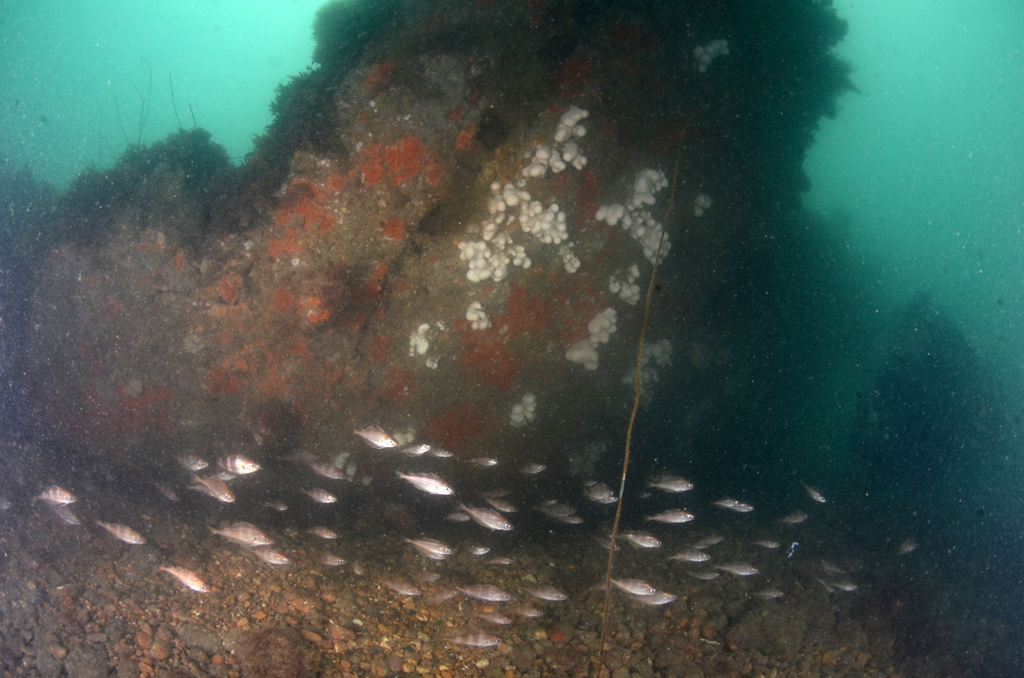
Our initial exercise was to search an area looking for a 'whale float' as described in the Dive Sussex (Book of lies). This was a real exercise of teamwork whereby 4 pairs of divers drifted to search an area 20m across for a length of 80m of the seabed. The most discussed theory worked well in practice and although we did not find the intended wreck target we did see a lovely large plaice about 50cm long. All gained some valuable experience of this search technique which may be useful in the future.
Our 2nd task was to dive the 'Crumbly Mulberry'. Thanks to some time spent on the boat looking for sites we were fairly confident that we had located it on our sonar. We successfully shotted the wreck and spent just under an hour swimming around the mini mulberry. A lot of tangled steel and broken concrete. There's a small wall with dead men's' fingers, conger eel and shoals of a young bib, Ballan wrasse and two-spotted gobies. It was a light and colourful site - good slack water and vis 3-4m. John and Neil took measurements, Mark and Ed sketched and got lost, Jim and Malcolm had a 90m swim off-site to look for more adventure!
Max depth 7m! we managed 2 dives totalling 75mins on a single 12L tank and still came out with 90bar!
Sunday 17 Aug
Weather unsuitable for diving
Monday 18 Aug
No diving while SSAC members attended the funeral of a well-loved and respected buddy, Dave Gilbert. RIP
Day 2 - Tue 19 Aug
Nice day but the wind picked up during the day.
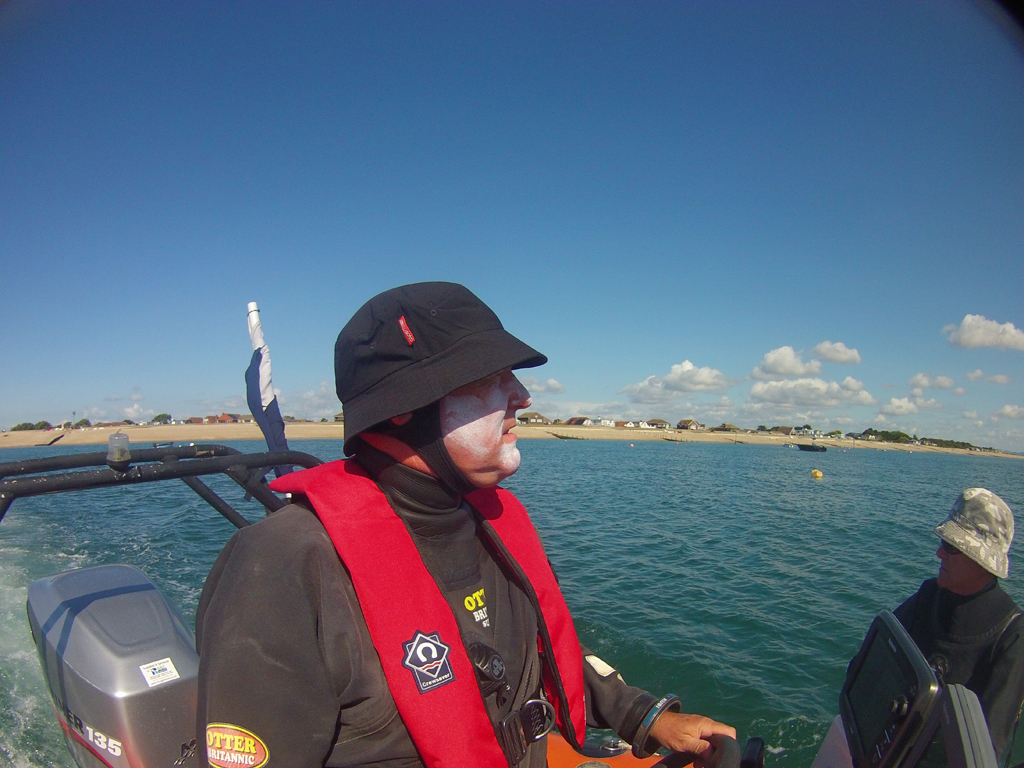
Dive 1 - We set out to dive an unidentified obstruction - Dive Sussex site no 96 with a position of 50 42'31" N 00 37' 42"W (which we converted to decimal WGS 84. Dive Sussex stated that no one had dived but likely to be Mulberry related. Described as 'tricky to find'. The closest UKHO data was 20081.
What a surprise we had! The site is a pile of rocks between 20-30cm high (granite?). At one end there appears to be a very old anchor and other structures. Some wood evident and a copper nailhead about 2cm across. We think this is an old wooden shipwreck which had lost all but its ballast and what remains of the hull beneath the seabed. May not have been carrying cargo or if it was... presume perishable. We took some photos and measurements of the anchor but visibility was poor and Martin and Ali were the only ones to find it despite only being a few metres from the shot. We had a rough guess of 12m by 6m and standing up 2m Martin thought slightly less which aligns with the UKHO data of 10x10m and 1.2m height. Certainly, one for the archaeologists to examine. More detail when we've had a chance to study images.
Conclusion.... nothing to do with Mulberry! (Dive Sussex AKA 'Book of Lies')
Dive 2 - We looked for another Dive Sussex site - Page 61 Site 69. 2 Beetles? Described as 2 small concrete chambers 50 yards apart. 50 44' 09"N 00 41' 36"W. We converted these to decimal WGS84 but could not pick up anything on our echo sounder and rather than waste the opportunity to dive we changed the site to the Inner Mullberry at Pagham. We had a nice dive here as this is one you can swim through from one side to the other as well as going around. There is quite a lot of metalwork over to one side, maybe some kind of lifting gear? We will need to study photos/drawings to have a better idea of what this is. Joe Bater rescued Ed's weight belt which fell from Malcolm's hands.
Day 3 - Wed 20 Aug
Beautiful morning, with light winds and mostly sunny. Suntan lotion and hat essential (photo to follow!)
Dive 1 - Whale Bridges.
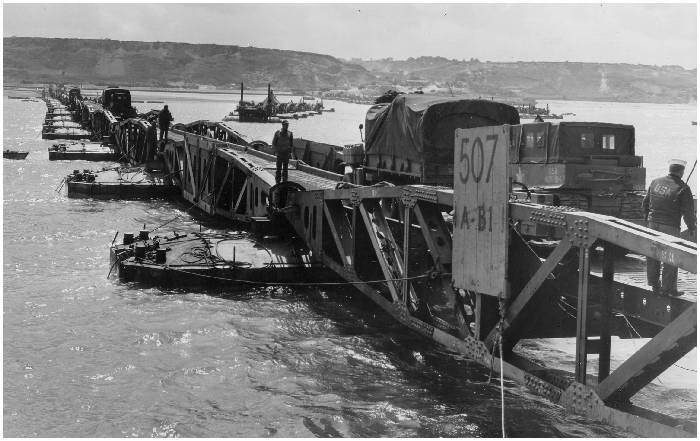
UKHO site 19988. This was our most demanding dive yet. Just over 32m and very dark/poor visibility of 1-2m. We think we found 2 whale bridge sections but this is a site we need to dive again to get our orientation and look around more. With such limited time on the site, it was tricky to work out how the bridge sections were lying. One, in particular, showed evidence of damage but they were obviously a bridge section. No obvious kite anchor but too early to say as there may be much more to the site... we just fumbled around what we did see. Some video but again hard to establish some parts. Did not see any beetles but that is not to say they are not there. Ed was delighted to successfully complete this dive which was his deepest UK dive and he was unsure how he would react in challenging conditions. He did really well and was looked after by Jim and Doug. All returned safely.
Dive 2 - Unidentified obstruction
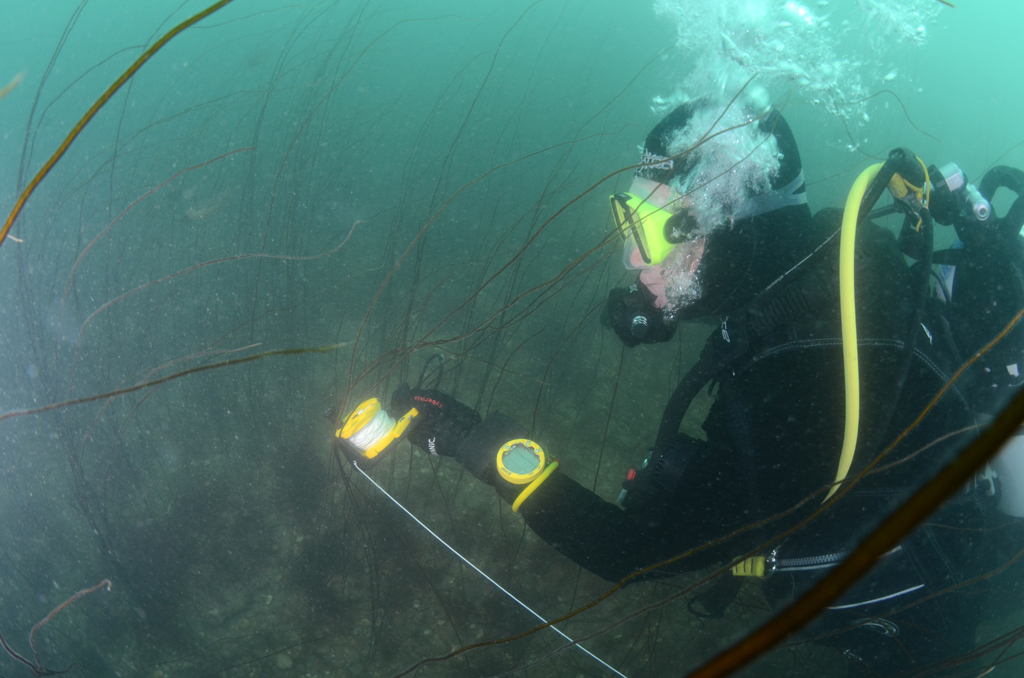
This was something we found whilst searching for objects last week with our echo sounder. We don't think it is in Dive Sussex or has a UKHO record (though we may be wrong). This turned out to be a rectangular steel pontoon type object approx. 1.5m high and some 20m long and 8m wide. Steel construction with a criss-cross of uprights and supports throughout its length. A shallow dive (8m), plenty of light and marine life although the current was a little strong. We will get the exact measurements from John Bohea and Ed tomorrow.
All in all the survey is already proving to be a worthwhile exercise - with (as we always seem to find) some surprising results.
The weather looking a little rough tomorrow so may only get one early dive in.
Thanks again to everyone including Tom Templeton for helming the boat for us over the last 2 days. The boat is proving to be comfortable, dry and reliable and a valuable asset thanks to Dave and Martin's efforts over the last year. There are still one or two refinements to be made and work is ongoing but not stopping the enjoyment of diving.
A Message From Our Diving Officer
- Details
- Category: Diving Officer Reports
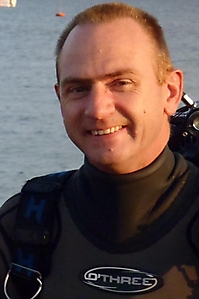
Hello and a warm welcome to Southsea Sub Aqua Club, my name is Martin Davies and I am the Diving Officer for the club. My role is to oversee all diving activities that the club does and to ensure that the dives we do as a club are done in a safe and consistent manner in line with our governing body’s “Safe diving practices”.
The British Sub Aqua Club has very high standards and we train long and hard to make us some of the best divers in the world. I am a big advocate of training and diving within the club environment, put simply it is the best way to learn and enjoy you’re diving.
The club offers many facilities whether you are just starting out or a hardened diver of many years. There is a structured dive schedule which has something for every diver in the club, you can choose how many dives you want to do and how much you want to participate within the club. The more you put in the more you get out; it’s a simple fact of life. You will meet a lot of likeminded people in the club who are passionate and enthusiastic about going diving, I started diving in 1977 at the tender age of 14 and have never looked back.
I have seen some spectacular sights and possibly been where no man or woman has ever gone before; I love the thought of exploration in the seas and oceans of this world we live in. Make the most of it:
“One life - dive it”!
These are edited versions of the diving officer’s report to the SSAC AGM. Each report is a pictorial record of some of the highlights of the year’s diving season.
Diving Officer Reports
-
 SSAC DO report 2017 [3 MB]
SSAC DO report 2017 [3 MB] -
 SSAC DO Report 2016 [1.44 MB]
SSAC DO Report 2016 [1.44 MB] -
 SSAC DO Report 2015 [1.43 MB]
SSAC DO Report 2015 [1.43 MB] -
 SSAC DO Report 2013 [5.44 MB]
SSAC DO Report 2013 [5.44 MB] -
 SSAC DO Report 2012 [6.35 MB]
SSAC DO Report 2012 [6.35 MB] -
 SSAC DO Report 2011 [2.12 MB]
SSAC DO Report 2011 [2.12 MB] -
 SSAC DO Report 2010 [2.27 MB]
SSAC DO Report 2010 [2.27 MB] -
 SSAC DO Report 2009 [3.2 MB]
SSAC DO Report 2009 [3.2 MB]
Submarine A1 Heritage Dive
- Details
- Category: HM Submarine A1
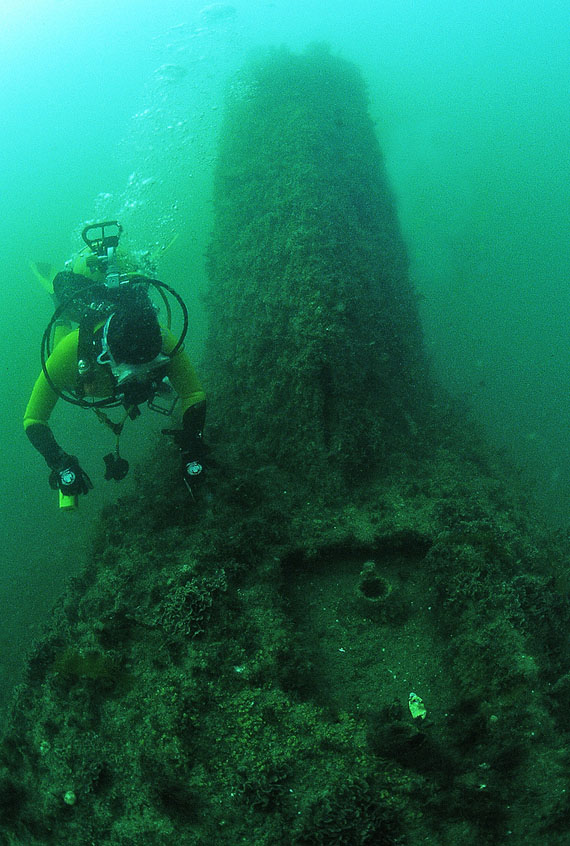 Want the chance to dive on the first British designed and built submarine?
Want the chance to dive on the first British designed and built submarine?
Submarine A1 sank in just 12m of water in 1911 and is now an officially protected wreck site. BSAC Southern region is arranging a day of diving for BSAC members on the historic site on 21 July 2013 which will give divers the chance to learn more about the fascinating history of the submarine from Southsea’s Diving Officer and A1 Licensee, Martin Davies as well as diving the wreck.
More information and to register an interest at the BSAC Southern Region web site.
Marvellous Manacles!
- Details
- Category: Trip Reports
March 2013: SSAC's first club trip of the year to Cornwall was a huge success.
Staying in nearby Flushing Cove and venturing out with our dive RHIB 'Alan Blake', the cold but calm waters of the Manacles reef provided excellent diving with visibility typically around 6-8m. The Manacles reef is renowned for its wrecks and marine life and provided some first-class diving despite being early in the season. The jewel anemones were particularly beautiful.
The holiday was also time to celebrate our Diving Officer Martin's significant birthday with a cake and a fish and chip supper for ten.
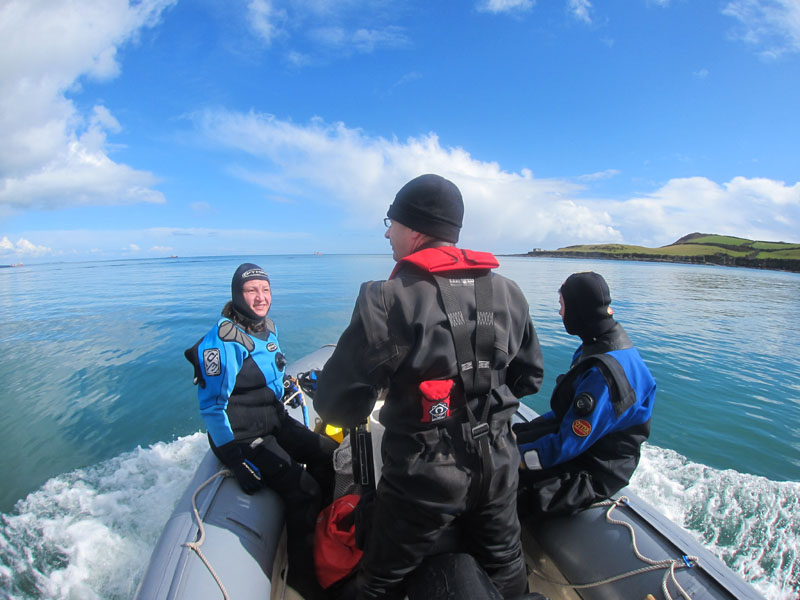
Eyemouth September 2012
- Details
- Category: Trip Reports
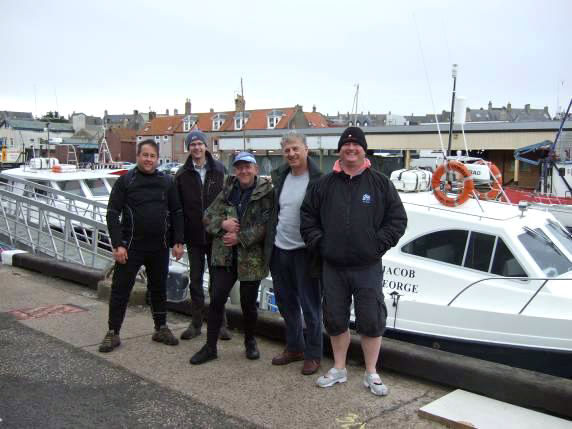
Straddling the English/Scottish border, the waters between Seahouses in Northumberland and the Scottish town of North Berwick are one of the finest diving areas in the UK and one we've wanted to visit for many years.
From the Farne Islands' seals and underwater cliffs in the south to the wrecks of steam-driven submarines off the Isle of May in the north, not forgetting Eyemouth's famous deep wrecks and the scenic masterpieces of St Abbs Head in between, the area's volcanic past has combined with the maritime casualties of war and weather to create an amazing variety of dive sites. In short, this is truly a "coast for all divers".
In early September 2012 a group of divers loosely connected with Southsea SAC spent a week based in the pretty port of Eyemouth experiencing it all for themselves.
Diving the Farnes to the Firth of Forth - scenic dives - SS President & Cathedral Rock from David Purvis on Vimeo.
Hope Cove May 2012
- Details
- Category: Trip Reports
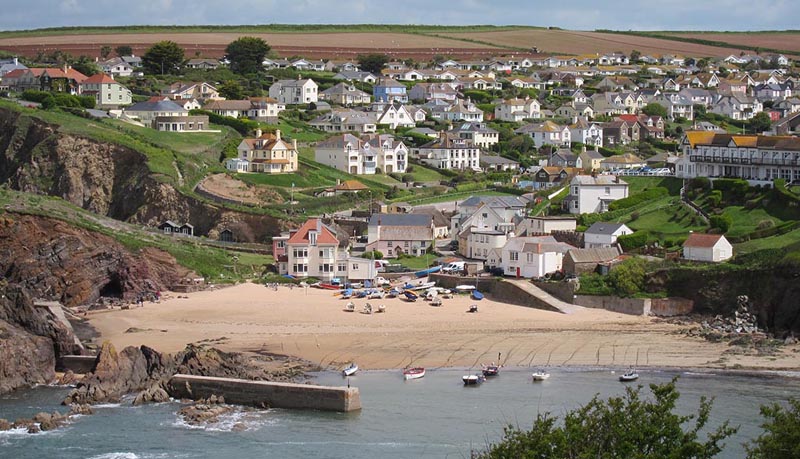
Hope Cove has been a favourite destination of SSAC for a number of years. The base is Shippen House, a 10-bed holiday home with excellent facilities overlooking the beach at Hope Cove in South Devon. It is also an opportunity to exercise the club rib away from its home base.
Friday – The journey from Portsmouth is about 4 – 5 hours. The boat arrives mid-afternoon and everyone settles into Shippen House ready for diving the next day. It’s a nice warm and sunny day. Doug rigs up a router to give house wide wi-fi access and we have our own internet café for the week.
Saturday – Diving the Maine. It’s dark and murky due to the rainwater run-off from the land. The two rib trips to the wreck were disappointing. James, Louis and Nick do a shore dive from Outer Hope beach to check equipment and buoyancy. This was a lovely sunny weekend and a wonderful sandy beach to enjoy when not diving or coxing the boat. Martin sets up his portable compressor to provide air. We also have a J cylinder of O2 to blend Nitrox mixes.
Sunday – Today we dived the Persier. Calm seas, sunshine and blue skies provide more promising conditions. There was good visibility on the wreck. Two trips were made to the wreck in Bigbury Bay. We also completed two drift dives in kelp close into the cliffs along Bolt Tail during the late afternoon and early evening.
Monday – Blown out and a lazy day.
Tuesday – Blown out again. Walk along Bolt Tail to Soar Mill Cove and Port Light hotel on Bolberry Down. We stop on the way back at the Port Light hotel for lunch. This was a former Golf course pavilion opened in 1907 and later used by the RAF in WWII as an airfield.
Wednesday – Dived the Persier in the morning and a sandy bottom in the vicinity of the Jebba wreck in the afternoon. Visibility on Persier was great, but the sandy bottom drift was nothing to write home about.
Thursday – Up early for a dive on the Maine. We sneak in another dive on the Maine before the weather worsens. This time the visibility is excellent and we have a most enjoyable dive. Later we haul out the boat and bring it back to the house for a good wash down.
Friday – Up early to clean the house and pack. We are away by 0930 and it is over for another year.
Some images from the Photo Gallery for the trip
Kimmeridge Easter Dip 2012
- Details
- Category: Trip Reports
Maldives Expedition 2011
- Details
- Category: Trip Reports
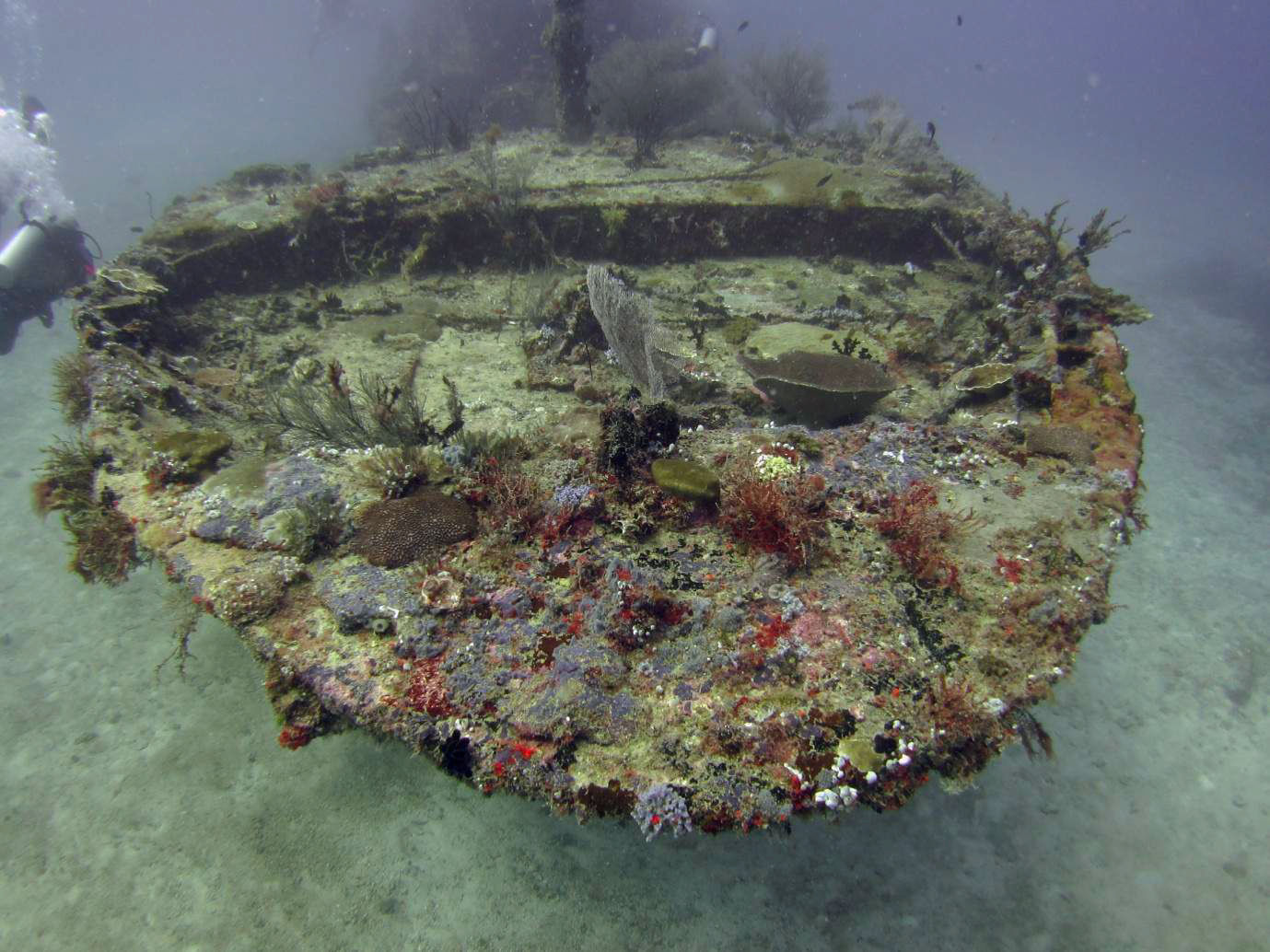
At last, 9 October arrived and it was time to depart on our long-awaited liveaboard trip in the Maldives. Dawn Barnard had put together an enticing expedition and 18 SSAC members, friends and spouses were off for a week on the liveaboard Orion cruising the Malé and Ari atolls, followed (for the majority of the party) by 3 days winding down on Bandos Island.
DAY 1: We arrived in the Maldives at midday on Monday 10 Oct 2011 after a reasonably comfortable 10-hour flight. It was then a short boat ride from the airport at Male to the MV Orion and a friendly welcome from the crew. We then had the rest of the afternoon to settle into our luxurious and very comfortable cabins.
DAY 2: Leaving Male early the next morning we arrived at Vihamanaa for a check dive at 0730. This was followed by our first exciting dive at Lankan Manta Point, where we see real Mantas, but not many; only 4. Still, it was a good start to the holiday and the promise of things to come. Banana reef was a bit of a letdown and not very inspiring with no Mantas, little marine life and poor coral.
DAY 3: Overnight to South Ari Atoll. The early morning dive was on a pinnacle known locally as a Thila. The place was teaming; with divers. There were many exotic species mainly from Italy, classified as thong exotica, and Japan, no buoyancy control ho and fin kick coral hi. Large shoals of Blue Striped Snapper and other fish joined the throng. Another Thila followed. After lunch, the boat suddenly turned about and raced towards a Whale Shark that has been sighted nearby. Mad panic as everyone prepared to enter the water at once to snorkel with the Whale Shark. Sadly, two other boats had the same idea and the Whale Shark finds itself surrounded by 60 guests all splashing around like very large baitfish. Un-phased by the commotion the Whale Shark stayed with us for 45 minutes giving many swimmers the opportunity to return to the Dhoni (dive boat) and don scuba equipment before diving with the Whale Shark again. We think this was a 6.5m female known as Ayesha because there is a small nick in her upper caudal (tail) fin. This was a thrilling experience for all of the tourists. It is not every day that you meet something three times your height and as placid as a teddy bear. Now back to the diving.
![]() Download the rest of the trip report by Tom Templeton.
Download the rest of the trip report by Tom Templeton.
Lymington June 2011
- Details
- Category: Trip Reports
4-5 June 2011
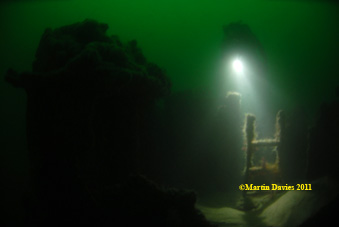
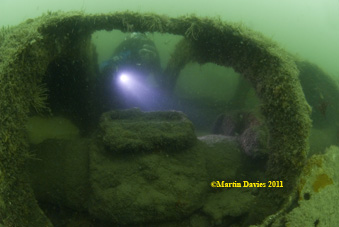
On 4 and 5 June 2011, divers from SSAC completed a weekend's diving on Wight Spirit, diving the wrecks of the SS Molina, SS Joannis Millas, LCT (30m) and SS War Knight - all to the west of the Isle of Wight.
The SS Molina sank in 1918 after being torpedoed by UB-35. Molina is an impressive wreck with a bow standing over 7m from the sea bed at 36m. Her large engine and boilers are clearly visible. Visibility was 8-10m.
SS Molina: single screwed steamer sunk by a torpedo from the German Submarine U-35 in 1918. Lies upright on a shingle bottom with a badly broken stern. Located five miles due South of the Isle of Wight. (Video by Chris Ringrose)
The second dive was the Joannis Millas which sank in 1896 having run aground.
Landing Craft Tank (30m) - given the club's recent success in investigating WW2 LCTs - was a good opportunity to investigate another LCT wreck, this time to the west of St Catherine's Point and lying at a maximum depth of 30m.
We then dived the War Knight which sank in 1918 after a collision, hitting a mine and gunfire! This is a large wreck (7,951 tons) in shallow water and one of the first merchant vessels to have a turbine engine.
Hope Cove 2011
- Details
- Category: Trip Reports
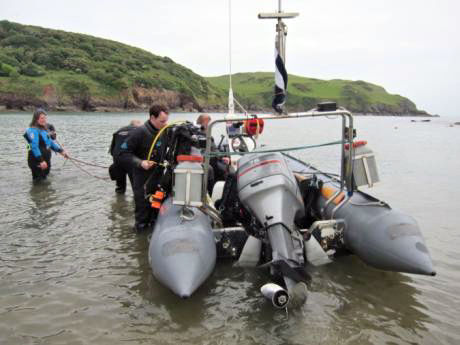
By 1400 on Friday afternoon we have the Club RHIB moored for the week at Inner Hope giving us easy access to South Devon wreck sites, such as the Maine and the Persier. The rest of the party arrive during the afternoon and evening.
Subcategories
Local Diving Information
![]()
Over the years our club has used a variety of local facilities to help us go diving. There are also a variety of different dive sites available to meet the needs of divers with a wide range of experience and interests.
- Boat Charters
- Launch sites
- Dive Shops (Gas & Gear)
- Inland diving
- Shore Dives
- Boat Dives
- Charts, tides & weather
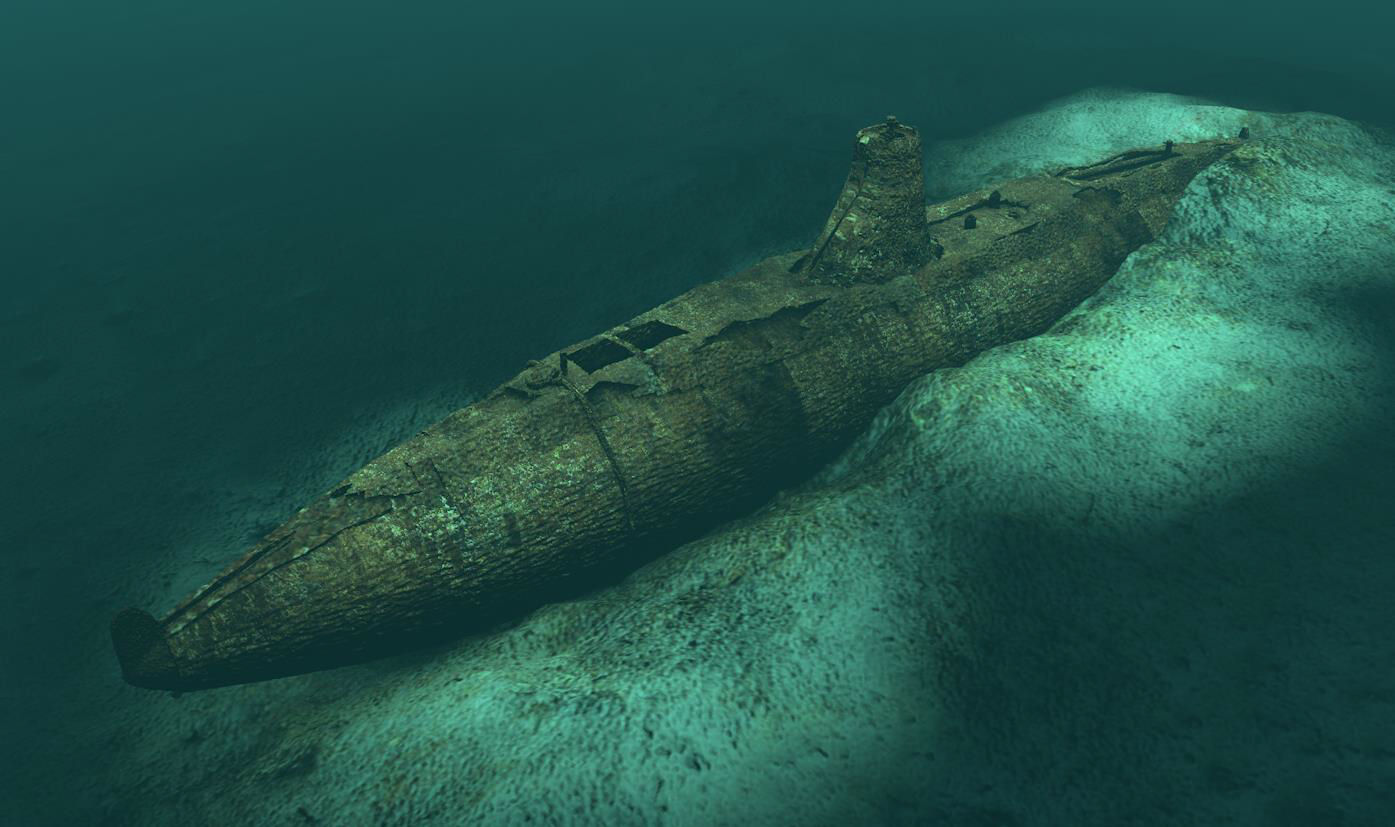
We are lucky to be located in the middle of the south coast. The local area offers the possibility of a range of diving from shallow easy dives for a trainee diver, to deeper, more challenging dives for the experienced mixed gas diver. The sites are often based around a wreck, with a few gullies or reefs too. The wrecks include a wide range of crafts. They are not limited to just shipwrecks from both wars, even if these are the more common. We have a range of historic sites including the Mulberry Harbours, Tanks & Bulldozers, aircraft, and submarines. There are a few protected sites too, such as the HMS A1, HMS Invincible & Thorness Bay protected wrecks which are diveable with the permission of the respective Licensees.
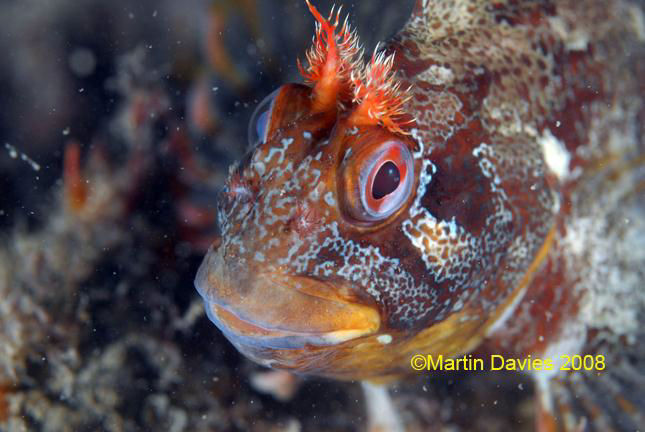
Sealife varies from season to season. It includes things such as sponges, pink fan coral, Pollack, blennies, pipefish, common starfish, painted top shells, whelks, mussels, oysters, scallops, cuttlefish, dogfish, wrasse, a variety of crabs, lobsters, eels, rays and many flatfish. If you are lucky, then you may be accompanied by a pod of dolphins on your way to the dive site!
Picking the right conditions can be tricky. The Solent Ooze covers some areas and can contribute to the debris floating in the water column. It isn’t helpful when the dredgers are busy improving the local harbours which would otherwise silt up. There are a couple of dumping grounds, the most popular being just south of the Nab Tower to the east of the shipping channel on the east side of the Isle of Wight.
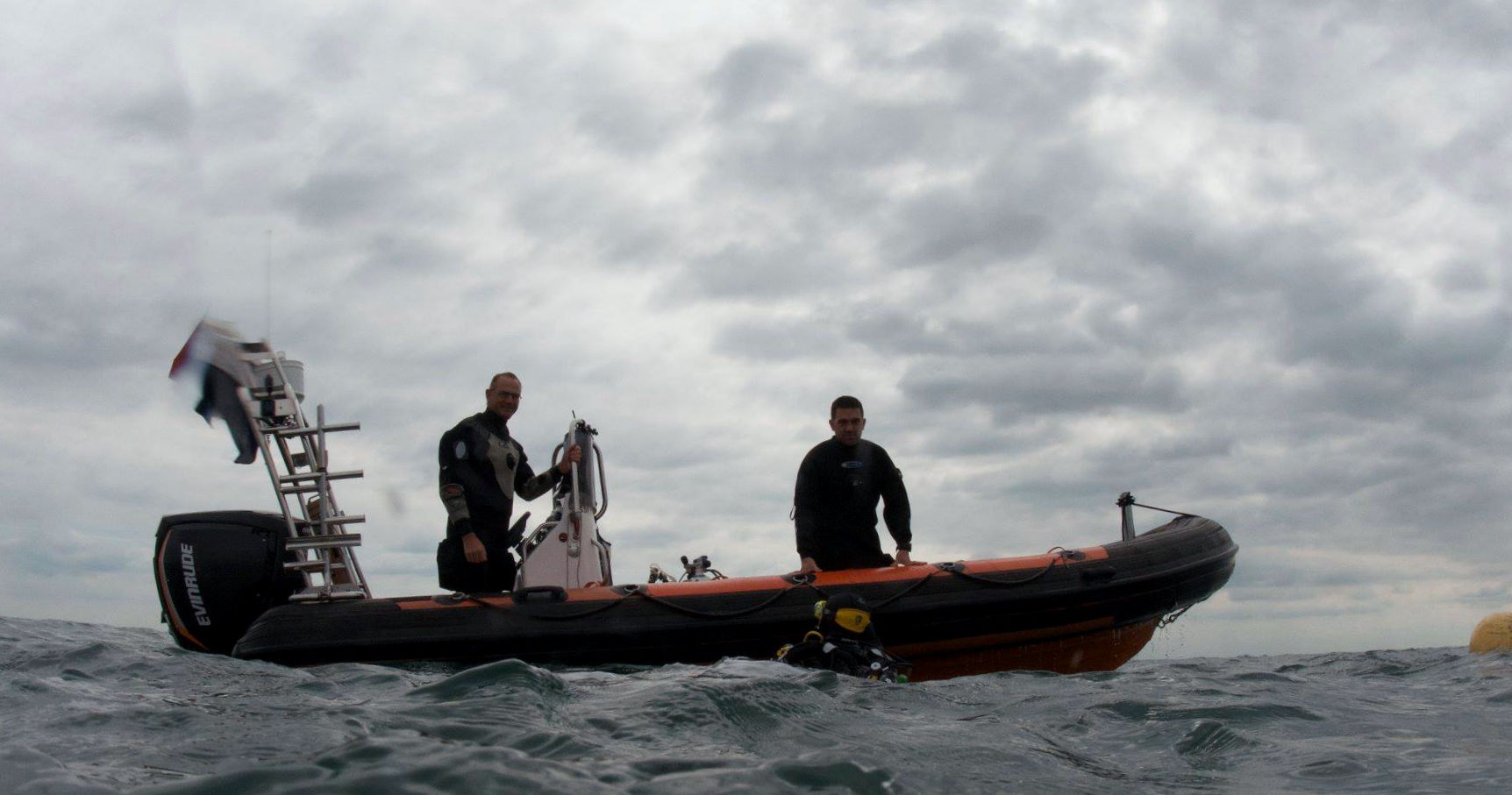
The local tidal forces are unique. The Isle of Wight has an effect and when the conditions are right, you can get a double high tide. This can make planning slack water “interesting” at times. Some areas are better dived at low water slack, whilst a few are better dived at high water slack. There are a handful of drift dives, but most diving is best completed on slack water.
Guides such as “Dive Isle of Wight and Hampshire” or “Dive Sussex” are useful for identifying many of the local dive sites. They haven’t been updated for a few years and there are several errors in many of the listed sites as a result of time and more up to date information becoming available. For more accurate GPS marks, it can be better to use the website https://www.wrecksite.eu/ .
![]() Return to the Local Diving info page...
Return to the Local Diving info page...
Trip Reports

Members of Southsea Sub-Aqua Club often plan a weekend, long weekend, week or longer trips together to a variety of places either in the UK or abroad. Sometimes a member of the group will put together a diary or report and illustrate it with some images of the holiday. Often too they'll include a little humour as well. Below are some diaries and reports of what they got up to on a few of the trips. Many are holidays and a few are about the expeditions or projects which members have been involved with too.
Diving Projects
Britain has relied upon the seas surrounding her for many millennia. Whether it has been for fishing, the import and export of goods, travelling and exploration or for protecting her shores from potential invaders. Occasionally a craft has failed to complete its journey and has sunk below the waves, leaving a wreck. More often this has been caused by a storm at sea, but can also have been caused by an accident (i.e. collision), navigational error or through warfare.
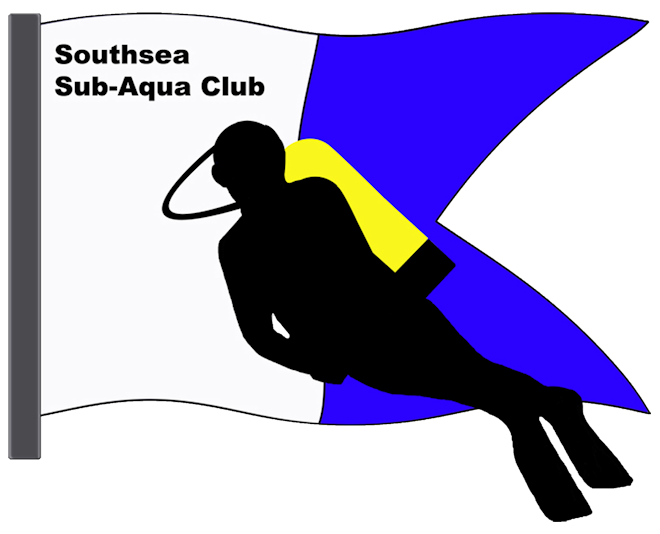
Southsea Sub-Aqua Club has a long history of wreck site investigation, the most well-known being "Project Solent Ships" which directly led to the discovery of the Mary Rose, but we didn't stop there. Over the years the Club has developed an association with a number of local wreck sites and some off the Normandy coast.
The projects involve a number of different types and ages of wrecks. They include ships, landing craft, aeroplanes, Mulberry harbours, armoured bulldozers and tanks from the two World Wars, as well as older wrecks, much older.
Today there are various courses available to help divers to record the sites and various members have completed such courses. They may have been completed within the club or through other organisations, such as the Nautical Archeology Society (NAS) or a University.
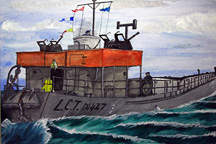
Some techniques have changed over the years as new technologies have become available. Where once an accurate sketch may have been sufficient, today you'll often find people still using tape measures and underwater slates, but also you'll find some using underwater cameras to help produce stills, video and 3D images. Often local and national news services have become interested in the stories of the projects too.
The articles below provide links to the various projects. They include photos and drawings of the sites, a record of the kind of life observed by the teams as well as some history to help bring them back to life.



